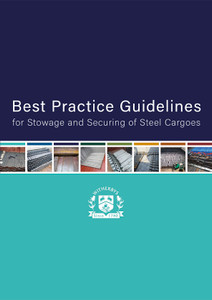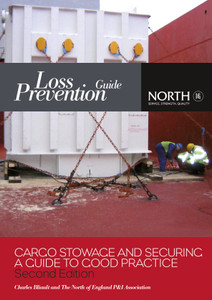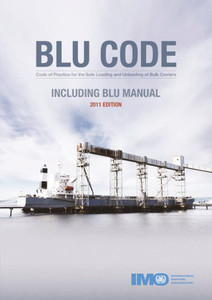
The Code of Safe Practice for Cargo Stowage and Securing (CSS Code) provides an international standard for the safe stowage and securing of cargoes to promote the safety of life both at sea, and during loading and discharge. The 2021 edition incorporates all amendments up to and including 2020.
In particular, this edition includes amendments to annex 13 on Methods to assess the efficiency of securing arrangements for semi-standardized and non-standardized cargo (MSC.1/Circ.1623), appendix 2 on Revised guidelines for the preparation of the Cargo Securing Manual (MSC.1/Circ.1353/Rev.2) and appendix 4 on Revised guidelines for securing arrangements for the transport of road vehicles on ro-ro ships (MSC.479(102)), which supersedes resolution A.581(14), as amended.
Also included in this 2021 edition of the Code are the Revised recommendations for entering enclosed spaces aboard ships (A.1050(27)), given in appendix 5, and amendments to annex 14 on Guidance on providing safe working conditions for securing of containers on deck (MSC.1/Circ.1352/Rev.1).
Preface
Upon instructions by the Maritime Safety Committee (MSC), the Sub-Committee on Containers and Cargoes (which was later superseded by the Sub-Committee on Dangerous Goods, Solid Cargoes and Containers) developed the Code of Safe Practice for Cargo Stowage and Securing. The Code was approved by the Committee at its fifty-eighth session (May 1990) and was adopted by the Assembly at its seventeenth regular session (November 1991) by resolution A.714(17).
The Assembly recommended that Governments implement the Code at the earliest possible opportunity and requested the MSC to keep it under review and amend it as necessary.
This edition of the Code includes the following amendments approved by the Committee at its one hundred and second session (4 to 11 November 2020): MSC.1/Circ.1623, which replaces the previous content of annex 13 on Methods to assess the efficiency of securing arrangements for semi-standardized and non-standardized cargo; MSC.1/Circ.1353/Rev.2 on Revised guidelines for the preparation of the Cargo Securing Manual, which supersedes MSC.1/Circ.1353/Rev.1 and is given in appendix 2; and resolution MSC.479(102) – Revised guidelines for securing arrangements for the transport of road vehicles on ro-ro ships, as set out in appendix 4, which supersedes resolution A.581(14), as amended.
Also included in this 2021 edition of the Code are amendments to annex 14, Guidance on providing safe working conditions for securing of containers on deck. These amendments were adopted on 15 December 2014 by MSC.1/Circ.1352/Rev.1 which revokes MSC.1/Circ.1352 and apply for containerships, the keels of which were laid or which are at a similar stage of construction on or after 1 January 2015. Sections 4.4 (Training and familiarization), 7.1 (Introduction), 7.3 (Maintenance) and section 8 (Specialized container safety design) apply to existing containerships, the keels of which were laid or which are at a similar stage of construction before 1 January 2015. Sections 6 (Design) and 7.2 (Operational procedures) apply to existing containerships, as far as practical by the flag State Administration, with the understanding that existing ships would not be required to be enlarged or undergo other major structural modifications as determined.
The Code includes, as appendices, various texts which have been issued by the Organization and are considered relevant to cargo stowage and securing. Any amendments or revisions, which may be made in the future, will be included in subsequent editions of this Code.
Preface
Resolution A.714(17)
Code of Safe Practice for Cargo Stowage and Securing
Code of Safe Practice for Cargo Stowage and Securing
Foreword
Chapter 1 General
Chapter 2 Principles of safe stowage and securing of cargoes
Chapter 3 Standardized stowage and securing systems
Chapter 4 Semi-standardized stowage and securing
Chapter 5 Non-standardized stowage and securing
Chapter 6 Actions which may be taken in heavy weather
Chapter 7 Actions which may be taken once cargo has shifted
Annex 1 Safe stowage and securing of containers on deck of ships which are not specially designed and fitted for the purpose of carrying containers
Annex 2 Safe stowage and securing of portable tanks
Annex 3 Safe stowage and securing of portable receptacles
Annex 4 Safe stowage and securing of wheel-based (rolling) cargoes
Annex 5 Safe stowage and securing of heavy cargo items such as locomotives, transformers, etc
Annex 6 Safe stowage and securing of coiled sheet steel
Annex 7 Safe stowage and securing of heavy metal products
Annex 8 Safe stowage and securing of anchor chains
Annex 9 Safe stowage and securing of metal scrap in bulk
Annex 10 Safe stowage and securing of flexible intermediate bulk containers
Annex 11 General guidelines for the under-deck stowage of logs
Annex 12 Safe stowage and securing of unit loads
Annex 13 Methods to assess the efficiency of securing arrangements for semi-standardized and non-standardized cargo.
Note on annex 14
Annex 14 Guidance on providing safe working conditions for securing of containers on deck
Appendices
Appendix 1 Resolution A.489(XII) – Safe stowage and securing of cargo units and other entities in ships other than cellular containerships
Appendix 2 Revised guidelines for the preparation of the Cargo Securing Manual (MSC.1/Circ.1353/Rev.2)
Appendix 3 Resolution A.533(13) – Elements to be taken into account when considering the safe stowage and securing of cargo units and vehicles in ships
Appendix 4 Resolution MSC.479(102) – Revised guidelines for securing arrangements for the transport of road vehicles on ro-ro ships
Appendix 5 Resolution A.864(20) – Recommendations for entering enclosed spaces aboard ships
IMO
As a specialised agency of the United Nations, the International Maritime Organization (IMO) is the global standard-setting authority for the safety, security and environmental performance of international shipping. Its main role is to create a regulatory framework for the shipping industry that is fair and effective, universally adopted and universally implemented.
In other words, its role is to create a level playing field so that ship operators cannot address their financial issues by simply cutting corners and compromising on safety, security and environmental performance. This approach also encourages innovation and efficiency.
Shipping is a truly international industry, and it can only operate effectively if the regulations and standards are themselves agreed, adopted and implemented on an international basis. And IMO is the forum at which this process takes place.
- Number of Pages:
- 179
- ISBN:
- 9789280117301
- Published Date:
- March 2021
- Book Height:
- 210 mm
- Book Width:
- 148 mm
- Weight:
- 0.4 kg
- Author:
IMO
- Preview:
- Yes
- Publication Date:
- March 2021






